WEL302A - Case Management: Collaborative Practice in Healthcare
VerifiedAdded on 2023/06/03
|9
|1748
|405
Report
AI Summary
This report examines the use of collaborative practice within case management in healthcare, emphasizing its role in service delivery. It defines case management and highlights collaborative practice's features, including need identification, assessment, and collaborative measures. The report uses examples to illustrate successful collaboration and cooperation, addressing challenges encountered. It further discusses the importance of collaboration in improving patient-centric care, reducing clinical errors, and ensuring patient needs are met effectively, referencing examples like Hospital-Community Collaboration. The report concludes that collaborative practice enhances case management by improving cost-effectiveness and patient care quality.

Running head: CASE MANAGEMENT AND COLLABORATIVE PRACTICE
Case Management and Collaborative Practice
Name of the Student:
Name of the University:
Author’s Note:
Case Management and Collaborative Practice
Name of the Student:
Name of the University:
Author’s Note:
Paraphrase This Document
Need a fresh take? Get an instant paraphrase of this document with our AI Paraphraser
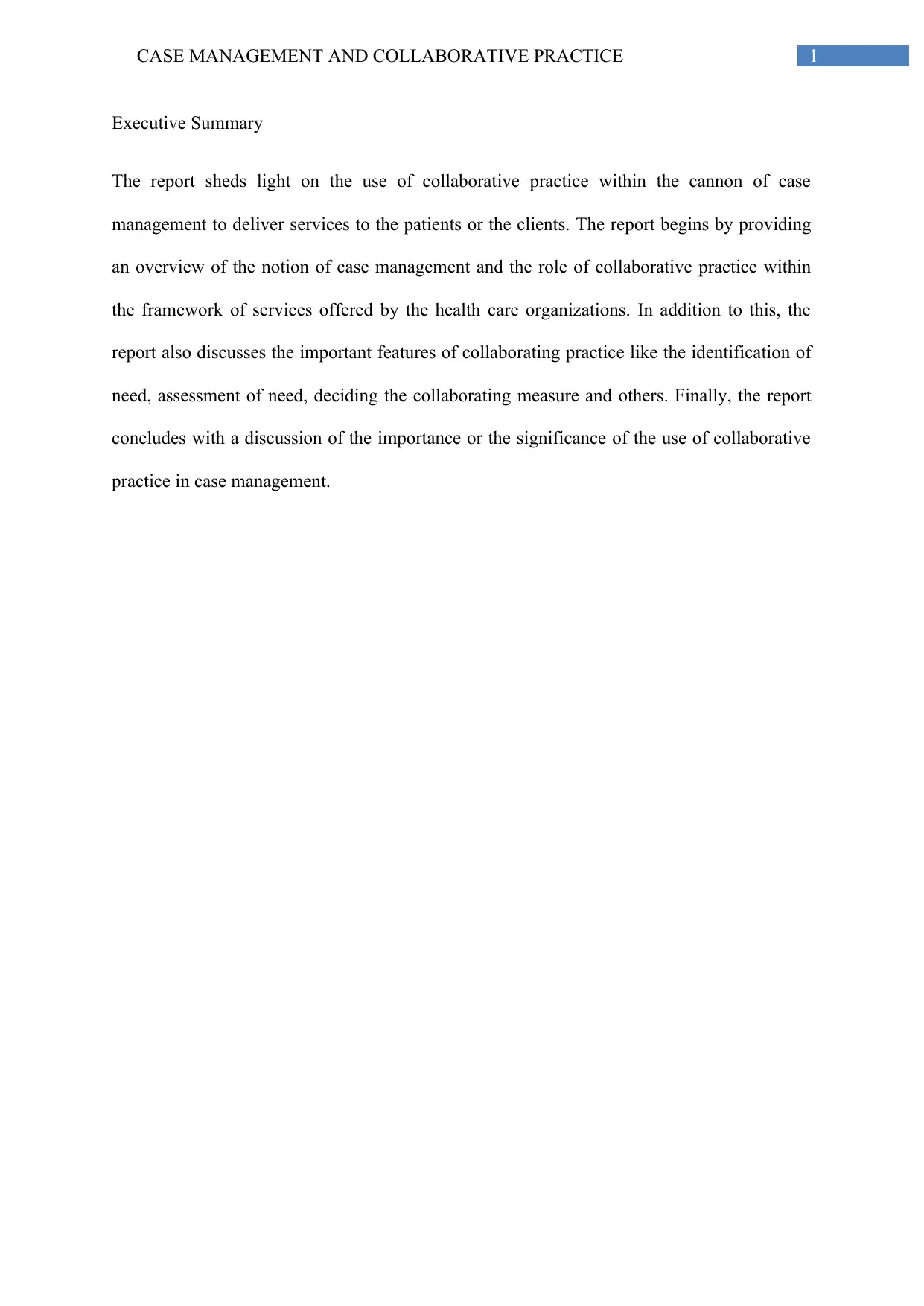
1CASE MANAGEMENT AND COLLABORATIVE PRACTICE
Executive Summary
The report sheds light on the use of collaborative practice within the cannon of case
management to deliver services to the patients or the clients. The report begins by providing
an overview of the notion of case management and the role of collaborative practice within
the framework of services offered by the health care organizations. In addition to this, the
report also discusses the important features of collaborating practice like the identification of
need, assessment of need, deciding the collaborating measure and others. Finally, the report
concludes with a discussion of the importance or the significance of the use of collaborative
practice in case management.
Executive Summary
The report sheds light on the use of collaborative practice within the cannon of case
management to deliver services to the patients or the clients. The report begins by providing
an overview of the notion of case management and the role of collaborative practice within
the framework of services offered by the health care organizations. In addition to this, the
report also discusses the important features of collaborating practice like the identification of
need, assessment of need, deciding the collaborating measure and others. Finally, the report
concludes with a discussion of the importance or the significance of the use of collaborative
practice in case management.
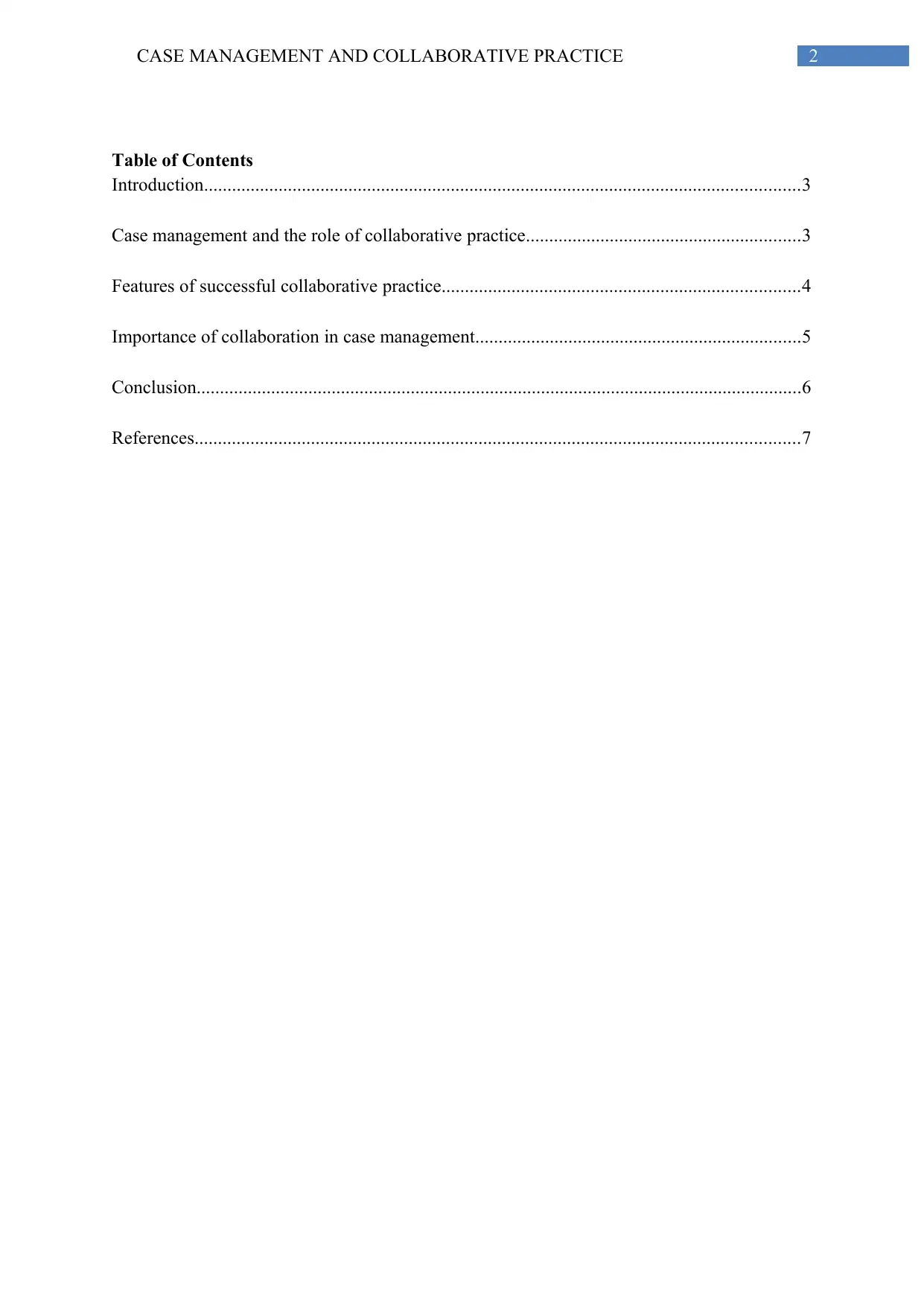
2CASE MANAGEMENT AND COLLABORATIVE PRACTICE
Table of Contents
Introduction................................................................................................................................3
Case management and the role of collaborative practice...........................................................3
Features of successful collaborative practice.............................................................................4
Importance of collaboration in case management......................................................................5
Conclusion..................................................................................................................................6
References..................................................................................................................................7
Table of Contents
Introduction................................................................................................................................3
Case management and the role of collaborative practice...........................................................3
Features of successful collaborative practice.............................................................................4
Importance of collaboration in case management......................................................................5
Conclusion..................................................................................................................................6
References..................................................................................................................................7
⊘ This is a preview!⊘
Do you want full access?
Subscribe today to unlock all pages.

Trusted by 1+ million students worldwide
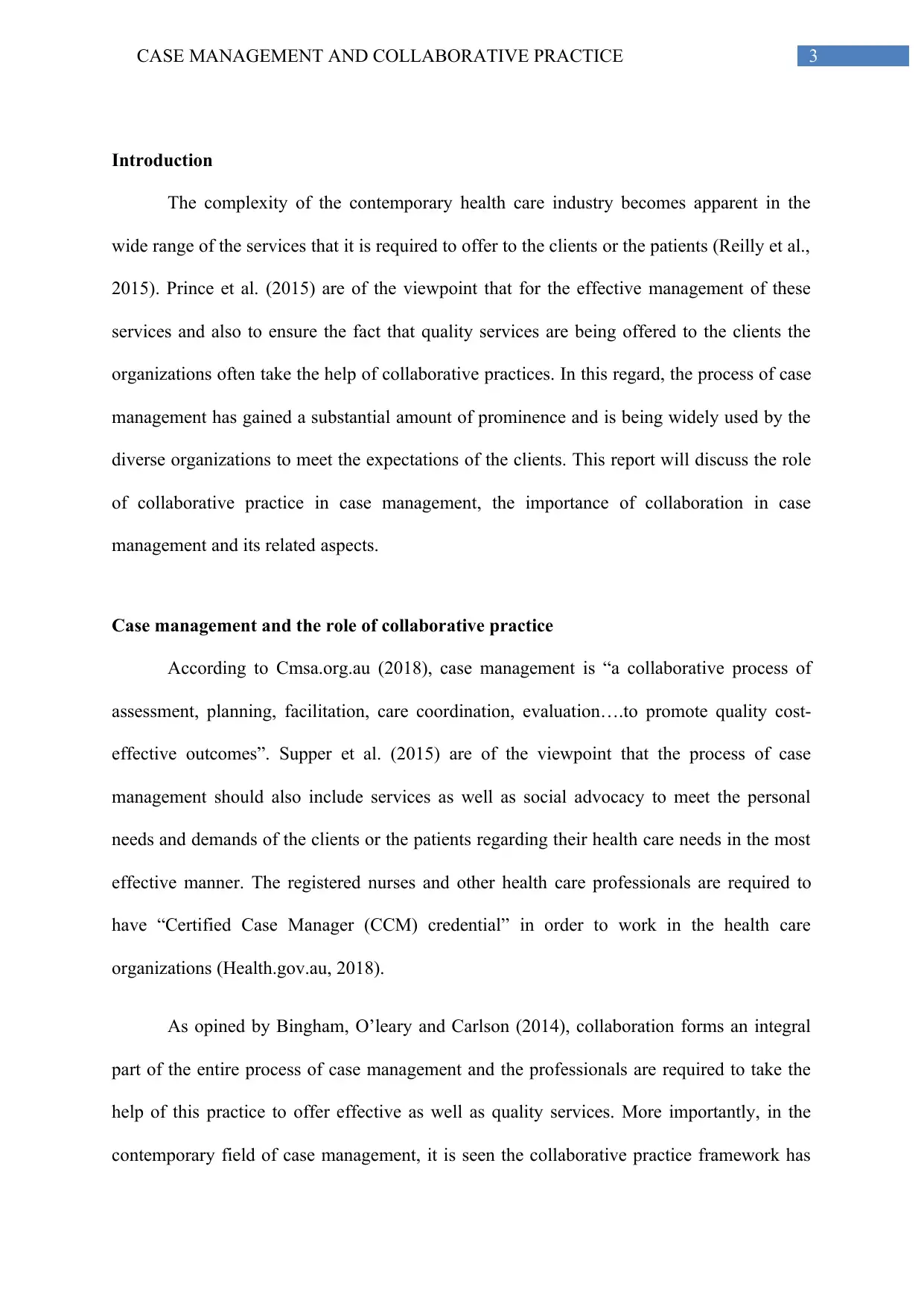
3CASE MANAGEMENT AND COLLABORATIVE PRACTICE
Introduction
The complexity of the contemporary health care industry becomes apparent in the
wide range of the services that it is required to offer to the clients or the patients (Reilly et al.,
2015). Prince et al. (2015) are of the viewpoint that for the effective management of these
services and also to ensure the fact that quality services are being offered to the clients the
organizations often take the help of collaborative practices. In this regard, the process of case
management has gained a substantial amount of prominence and is being widely used by the
diverse organizations to meet the expectations of the clients. This report will discuss the role
of collaborative practice in case management, the importance of collaboration in case
management and its related aspects.
Case management and the role of collaborative practice
According to Cmsa.org.au (2018), case management is “a collaborative process of
assessment, planning, facilitation, care coordination, evaluation….to promote quality cost-
effective outcomes”. Supper et al. (2015) are of the viewpoint that the process of case
management should also include services as well as social advocacy to meet the personal
needs and demands of the clients or the patients regarding their health care needs in the most
effective manner. The registered nurses and other health care professionals are required to
have “Certified Case Manager (CCM) credential” in order to work in the health care
organizations (Health.gov.au, 2018).
As opined by Bingham, O’leary and Carlson (2014), collaboration forms an integral
part of the entire process of case management and the professionals are required to take the
help of this practice to offer effective as well as quality services. More importantly, in the
contemporary field of case management, it is seen the collaborative practice framework has
Introduction
The complexity of the contemporary health care industry becomes apparent in the
wide range of the services that it is required to offer to the clients or the patients (Reilly et al.,
2015). Prince et al. (2015) are of the viewpoint that for the effective management of these
services and also to ensure the fact that quality services are being offered to the clients the
organizations often take the help of collaborative practices. In this regard, the process of case
management has gained a substantial amount of prominence and is being widely used by the
diverse organizations to meet the expectations of the clients. This report will discuss the role
of collaborative practice in case management, the importance of collaboration in case
management and its related aspects.
Case management and the role of collaborative practice
According to Cmsa.org.au (2018), case management is “a collaborative process of
assessment, planning, facilitation, care coordination, evaluation….to promote quality cost-
effective outcomes”. Supper et al. (2015) are of the viewpoint that the process of case
management should also include services as well as social advocacy to meet the personal
needs and demands of the clients or the patients regarding their health care needs in the most
effective manner. The registered nurses and other health care professionals are required to
have “Certified Case Manager (CCM) credential” in order to work in the health care
organizations (Health.gov.au, 2018).
As opined by Bingham, O’leary and Carlson (2014), collaboration forms an integral
part of the entire process of case management and the professionals are required to take the
help of this practice to offer effective as well as quality services. More importantly, in the
contemporary field of case management, it is seen the collaborative practice framework has
Paraphrase This Document
Need a fresh take? Get an instant paraphrase of this document with our AI Paraphraser
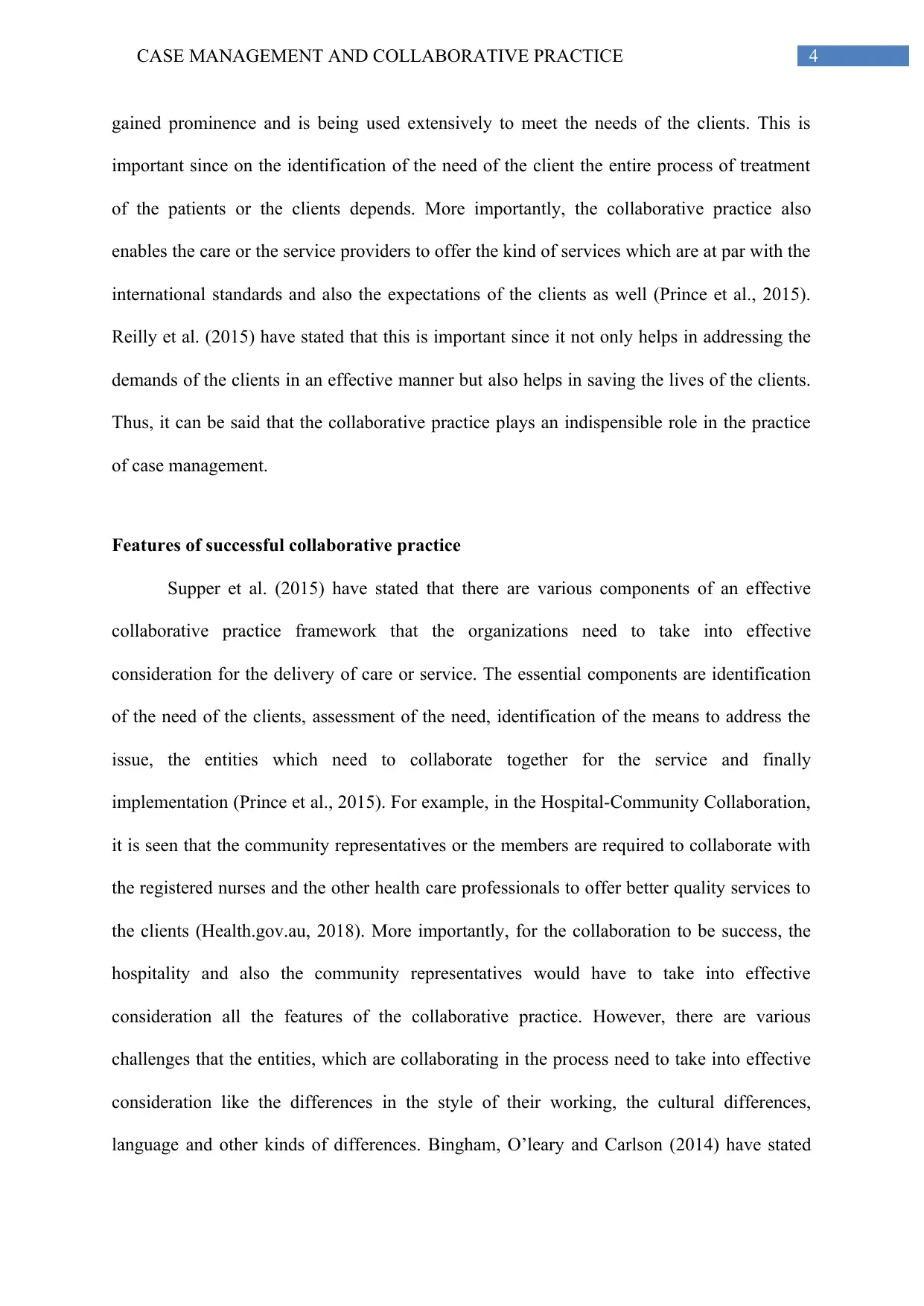
4CASE MANAGEMENT AND COLLABORATIVE PRACTICE
gained prominence and is being used extensively to meet the needs of the clients. This is
important since on the identification of the need of the client the entire process of treatment
of the patients or the clients depends. More importantly, the collaborative practice also
enables the care or the service providers to offer the kind of services which are at par with the
international standards and also the expectations of the clients as well (Prince et al., 2015).
Reilly et al. (2015) have stated that this is important since it not only helps in addressing the
demands of the clients in an effective manner but also helps in saving the lives of the clients.
Thus, it can be said that the collaborative practice plays an indispensible role in the practice
of case management.
Features of successful collaborative practice
Supper et al. (2015) have stated that there are various components of an effective
collaborative practice framework that the organizations need to take into effective
consideration for the delivery of care or service. The essential components are identification
of the need of the clients, assessment of the need, identification of the means to address the
issue, the entities which need to collaborate together for the service and finally
implementation (Prince et al., 2015). For example, in the Hospital-Community Collaboration,
it is seen that the community representatives or the members are required to collaborate with
the registered nurses and the other health care professionals to offer better quality services to
the clients (Health.gov.au, 2018). More importantly, for the collaboration to be success, the
hospitality and also the community representatives would have to take into effective
consideration all the features of the collaborative practice. However, there are various
challenges that the entities, which are collaborating in the process need to take into effective
consideration like the differences in the style of their working, the cultural differences,
language and other kinds of differences. Bingham, O’leary and Carlson (2014) have stated
gained prominence and is being used extensively to meet the needs of the clients. This is
important since on the identification of the need of the client the entire process of treatment
of the patients or the clients depends. More importantly, the collaborative practice also
enables the care or the service providers to offer the kind of services which are at par with the
international standards and also the expectations of the clients as well (Prince et al., 2015).
Reilly et al. (2015) have stated that this is important since it not only helps in addressing the
demands of the clients in an effective manner but also helps in saving the lives of the clients.
Thus, it can be said that the collaborative practice plays an indispensible role in the practice
of case management.
Features of successful collaborative practice
Supper et al. (2015) have stated that there are various components of an effective
collaborative practice framework that the organizations need to take into effective
consideration for the delivery of care or service. The essential components are identification
of the need of the clients, assessment of the need, identification of the means to address the
issue, the entities which need to collaborate together for the service and finally
implementation (Prince et al., 2015). For example, in the Hospital-Community Collaboration,
it is seen that the community representatives or the members are required to collaborate with
the registered nurses and the other health care professionals to offer better quality services to
the clients (Health.gov.au, 2018). More importantly, for the collaboration to be success, the
hospitality and also the community representatives would have to take into effective
consideration all the features of the collaborative practice. However, there are various
challenges that the entities, which are collaborating in the process need to take into effective
consideration like the differences in the style of their working, the cultural differences,
language and other kinds of differences. Bingham, O’leary and Carlson (2014) have stated
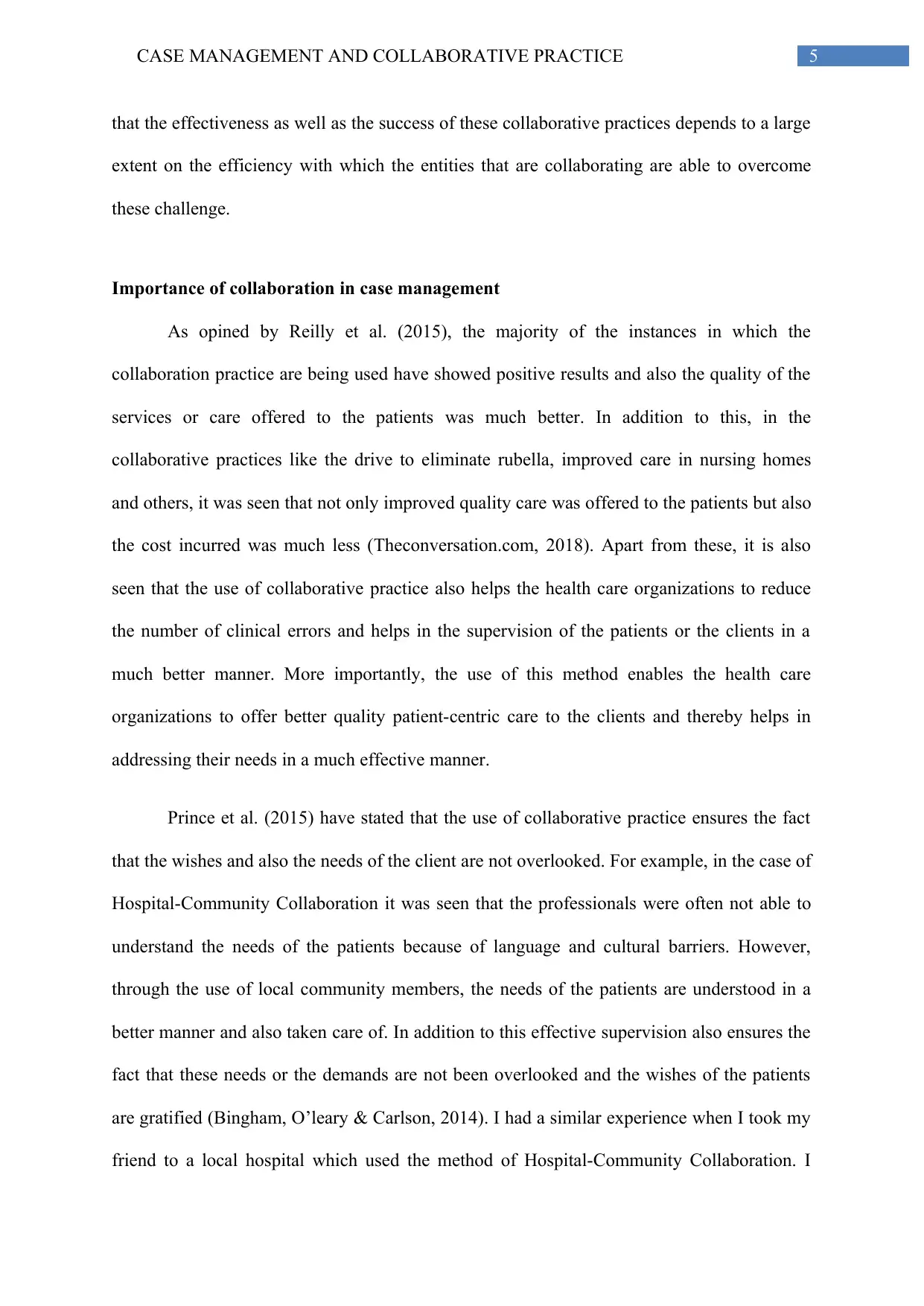
5CASE MANAGEMENT AND COLLABORATIVE PRACTICE
that the effectiveness as well as the success of these collaborative practices depends to a large
extent on the efficiency with which the entities that are collaborating are able to overcome
these challenge.
Importance of collaboration in case management
As opined by Reilly et al. (2015), the majority of the instances in which the
collaboration practice are being used have showed positive results and also the quality of the
services or care offered to the patients was much better. In addition to this, in the
collaborative practices like the drive to eliminate rubella, improved care in nursing homes
and others, it was seen that not only improved quality care was offered to the patients but also
the cost incurred was much less (Theconversation.com, 2018). Apart from these, it is also
seen that the use of collaborative practice also helps the health care organizations to reduce
the number of clinical errors and helps in the supervision of the patients or the clients in a
much better manner. More importantly, the use of this method enables the health care
organizations to offer better quality patient-centric care to the clients and thereby helps in
addressing their needs in a much effective manner.
Prince et al. (2015) have stated that the use of collaborative practice ensures the fact
that the wishes and also the needs of the client are not overlooked. For example, in the case of
Hospital-Community Collaboration it was seen that the professionals were often not able to
understand the needs of the patients because of language and cultural barriers. However,
through the use of local community members, the needs of the patients are understood in a
better manner and also taken care of. In addition to this effective supervision also ensures the
fact that these needs or the demands are not been overlooked and the wishes of the patients
are gratified (Bingham, O’leary & Carlson, 2014). I had a similar experience when I took my
friend to a local hospital which used the method of Hospital-Community Collaboration. I
that the effectiveness as well as the success of these collaborative practices depends to a large
extent on the efficiency with which the entities that are collaborating are able to overcome
these challenge.
Importance of collaboration in case management
As opined by Reilly et al. (2015), the majority of the instances in which the
collaboration practice are being used have showed positive results and also the quality of the
services or care offered to the patients was much better. In addition to this, in the
collaborative practices like the drive to eliminate rubella, improved care in nursing homes
and others, it was seen that not only improved quality care was offered to the patients but also
the cost incurred was much less (Theconversation.com, 2018). Apart from these, it is also
seen that the use of collaborative practice also helps the health care organizations to reduce
the number of clinical errors and helps in the supervision of the patients or the clients in a
much better manner. More importantly, the use of this method enables the health care
organizations to offer better quality patient-centric care to the clients and thereby helps in
addressing their needs in a much effective manner.
Prince et al. (2015) have stated that the use of collaborative practice ensures the fact
that the wishes and also the needs of the client are not overlooked. For example, in the case of
Hospital-Community Collaboration it was seen that the professionals were often not able to
understand the needs of the patients because of language and cultural barriers. However,
through the use of local community members, the needs of the patients are understood in a
better manner and also taken care of. In addition to this effective supervision also ensures the
fact that these needs or the demands are not been overlooked and the wishes of the patients
are gratified (Bingham, O’leary & Carlson, 2014). I had a similar experience when I took my
friend to a local hospital which used the method of Hospital-Community Collaboration. I
⊘ This is a preview!⊘
Do you want full access?
Subscribe today to unlock all pages.

Trusted by 1+ million students worldwide
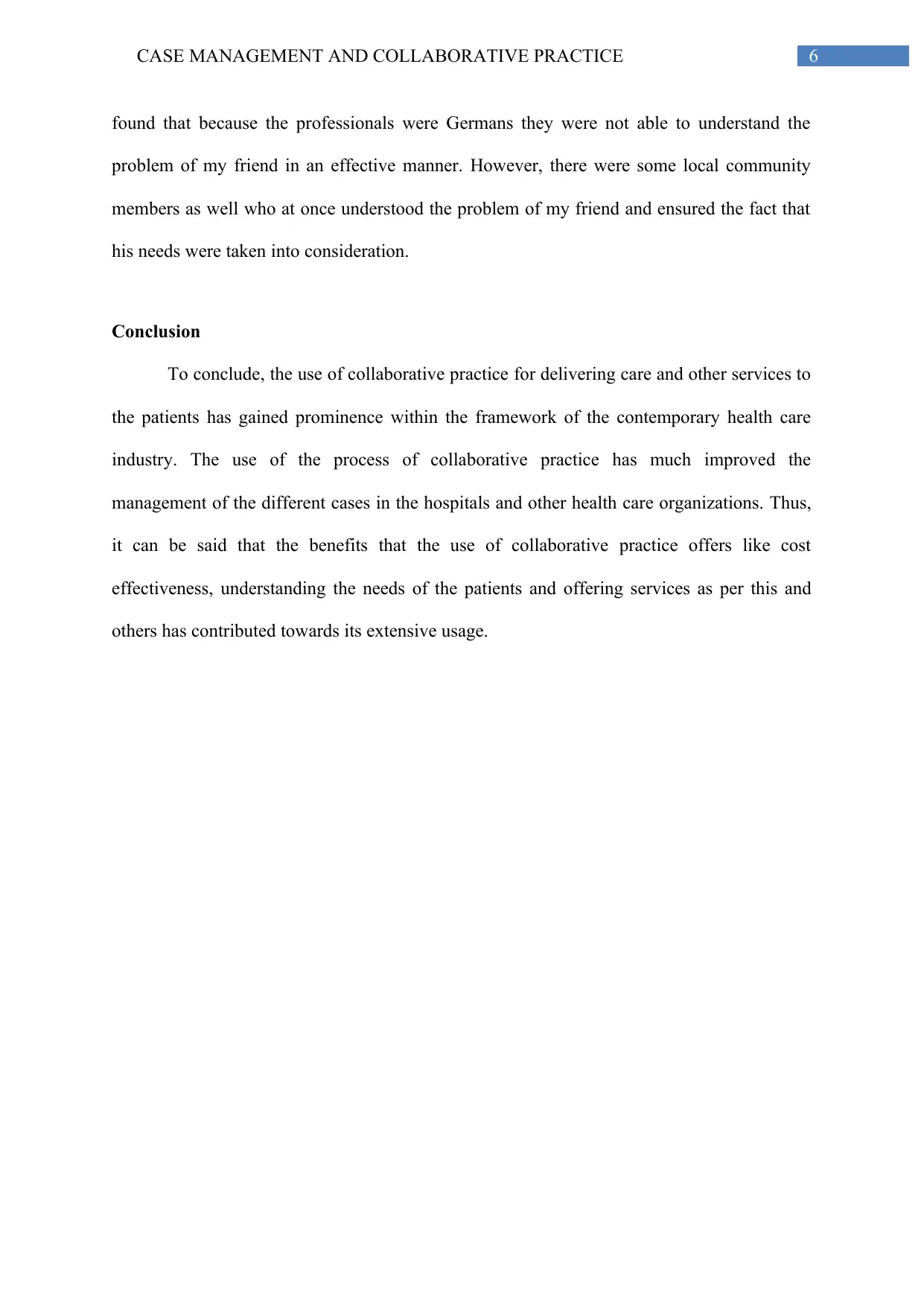
6CASE MANAGEMENT AND COLLABORATIVE PRACTICE
found that because the professionals were Germans they were not able to understand the
problem of my friend in an effective manner. However, there were some local community
members as well who at once understood the problem of my friend and ensured the fact that
his needs were taken into consideration.
Conclusion
To conclude, the use of collaborative practice for delivering care and other services to
the patients has gained prominence within the framework of the contemporary health care
industry. The use of the process of collaborative practice has much improved the
management of the different cases in the hospitals and other health care organizations. Thus,
it can be said that the benefits that the use of collaborative practice offers like cost
effectiveness, understanding the needs of the patients and offering services as per this and
others has contributed towards its extensive usage.
found that because the professionals were Germans they were not able to understand the
problem of my friend in an effective manner. However, there were some local community
members as well who at once understood the problem of my friend and ensured the fact that
his needs were taken into consideration.
Conclusion
To conclude, the use of collaborative practice for delivering care and other services to
the patients has gained prominence within the framework of the contemporary health care
industry. The use of the process of collaborative practice has much improved the
management of the different cases in the hospitals and other health care organizations. Thus,
it can be said that the benefits that the use of collaborative practice offers like cost
effectiveness, understanding the needs of the patients and offering services as per this and
others has contributed towards its extensive usage.
Paraphrase This Document
Need a fresh take? Get an instant paraphrase of this document with our AI Paraphraser
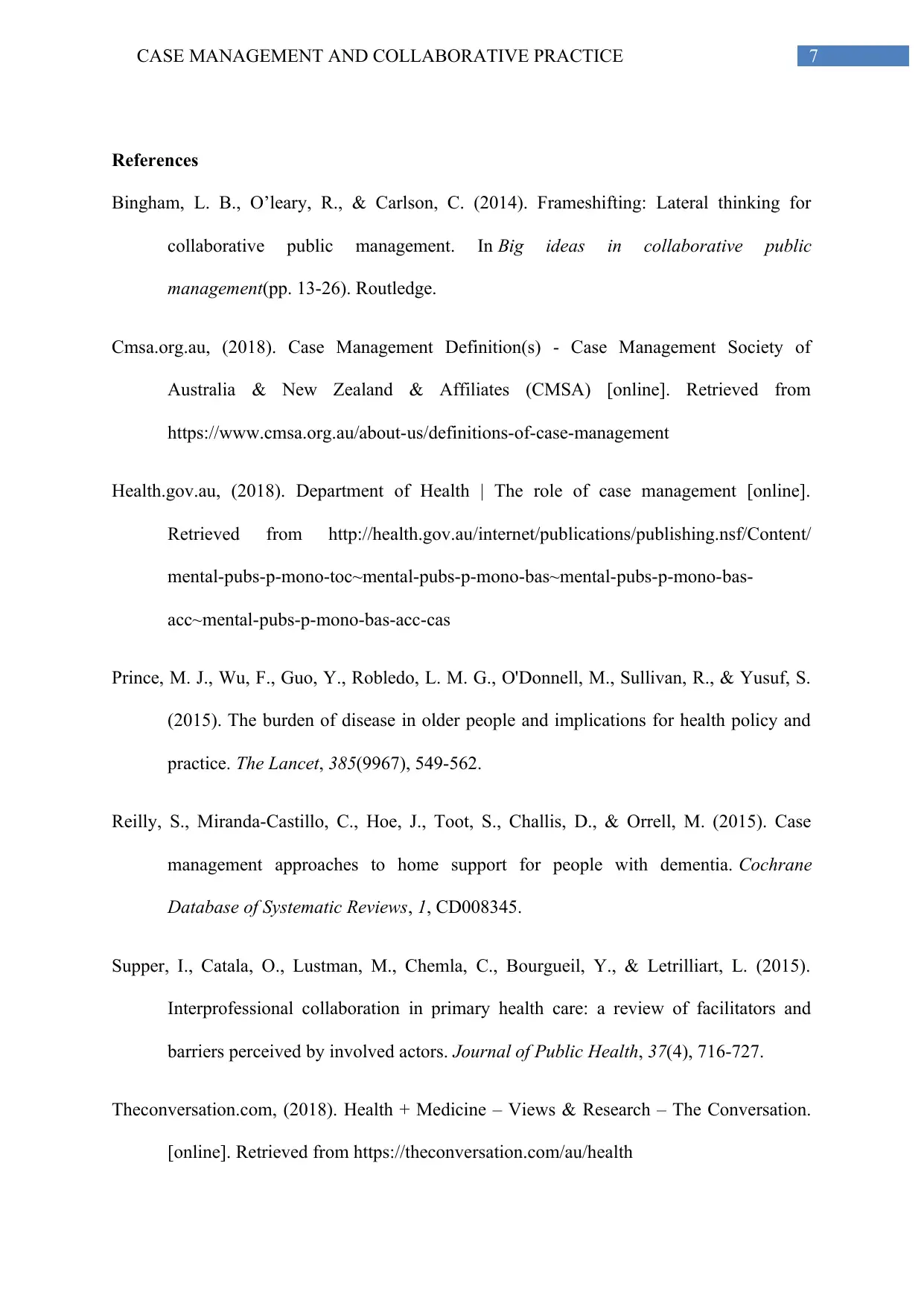
7CASE MANAGEMENT AND COLLABORATIVE PRACTICE
References
Bingham, L. B., O’leary, R., & Carlson, C. (2014). Frameshifting: Lateral thinking for
collaborative public management. In Big ideas in collaborative public
management(pp. 13-26). Routledge.
Cmsa.org.au, (2018). Case Management Definition(s) - Case Management Society of
Australia & New Zealand & Affiliates (CMSA) [online]. Retrieved from
https://www.cmsa.org.au/about-us/definitions-of-case-management
Health.gov.au, (2018). Department of Health | The role of case management [online].
Retrieved from http://health.gov.au/internet/publications/publishing.nsf/Content/
mental-pubs-p-mono-toc~mental-pubs-p-mono-bas~mental-pubs-p-mono-bas-
acc~mental-pubs-p-mono-bas-acc-cas
Prince, M. J., Wu, F., Guo, Y., Robledo, L. M. G., O'Donnell, M., Sullivan, R., & Yusuf, S.
(2015). The burden of disease in older people and implications for health policy and
practice. The Lancet, 385(9967), 549-562.
Reilly, S., Miranda-Castillo, C., Hoe, J., Toot, S., Challis, D., & Orrell, M. (2015). Case
management approaches to home support for people with dementia. Cochrane
Database of Systematic Reviews, 1, CD008345.
Supper, I., Catala, O., Lustman, M., Chemla, C., Bourgueil, Y., & Letrilliart, L. (2015).
Interprofessional collaboration in primary health care: a review of facilitators and
barriers perceived by involved actors. Journal of Public Health, 37(4), 716-727.
Theconversation.com, (2018). Health + Medicine – Views & Research – The Conversation.
[online]. Retrieved from https://theconversation.com/au/health
References
Bingham, L. B., O’leary, R., & Carlson, C. (2014). Frameshifting: Lateral thinking for
collaborative public management. In Big ideas in collaborative public
management(pp. 13-26). Routledge.
Cmsa.org.au, (2018). Case Management Definition(s) - Case Management Society of
Australia & New Zealand & Affiliates (CMSA) [online]. Retrieved from
https://www.cmsa.org.au/about-us/definitions-of-case-management
Health.gov.au, (2018). Department of Health | The role of case management [online].
Retrieved from http://health.gov.au/internet/publications/publishing.nsf/Content/
mental-pubs-p-mono-toc~mental-pubs-p-mono-bas~mental-pubs-p-mono-bas-
acc~mental-pubs-p-mono-bas-acc-cas
Prince, M. J., Wu, F., Guo, Y., Robledo, L. M. G., O'Donnell, M., Sullivan, R., & Yusuf, S.
(2015). The burden of disease in older people and implications for health policy and
practice. The Lancet, 385(9967), 549-562.
Reilly, S., Miranda-Castillo, C., Hoe, J., Toot, S., Challis, D., & Orrell, M. (2015). Case
management approaches to home support for people with dementia. Cochrane
Database of Systematic Reviews, 1, CD008345.
Supper, I., Catala, O., Lustman, M., Chemla, C., Bourgueil, Y., & Letrilliart, L. (2015).
Interprofessional collaboration in primary health care: a review of facilitators and
barriers perceived by involved actors. Journal of Public Health, 37(4), 716-727.
Theconversation.com, (2018). Health + Medicine – Views & Research – The Conversation.
[online]. Retrieved from https://theconversation.com/au/health

8CASE MANAGEMENT AND COLLABORATIVE PRACTICE
⊘ This is a preview!⊘
Do you want full access?
Subscribe today to unlock all pages.

Trusted by 1+ million students worldwide
1 out of 9
Related Documents
Your All-in-One AI-Powered Toolkit for Academic Success.
+13062052269
info@desklib.com
Available 24*7 on WhatsApp / Email
![[object Object]](/_next/static/media/star-bottom.7253800d.svg)
Unlock your academic potential
Copyright © 2020–2025 A2Z Services. All Rights Reserved. Developed and managed by ZUCOL.





